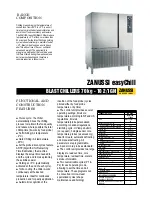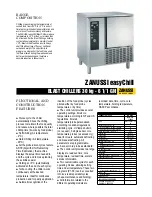
27
9 - NOMINAl EVAPORATOR WATER FlOW CONTROl
The water circulation pumps of the 30RW/RWA units have
been sized to allow the hydronic modules to cover all
pos-sible configurations based on the specific installation
con-ditions, i.e. for various temperature differences
between the entering and the leaving water (∆T) at full
load, which can vary between 3 and 10 K.
This required difference between the entering and leaving
water temperature determines the nominal system flow rate.
It is above all absolutely necessary to know the nominal
system flow rate to allow its control via a manual valve
provided in the water leaving piping of the module (item 9
in the typical hydronic circuit diagram).
With the pressure loss generated by the control valve in
the hydronic system, the valve is able to impose the system
pressure/flow curve on the pump pressure/flow curve, to
obtain the desired operating point (see example).
The pressure drop reading in the plate heat exchanger is
used to control and adjust the nominal system flow rate.
The pressure drop is measured with the pressure gauge
connected to the heat exchanger water inlet and outlet.
Use this specification for the unit selection to know the
system operating conditions and to deduce the nominal air
flow as well as the plate heat exchanger pressure drop at the
specified conditions. If this information is not available at
the system start-up, contact the technical service department
responsible for the installation to get it.
These characteristics can be obtained from the technical
literature using the unit performance tables for a ∆T of 5 K
at the evaporator or with the Electronic Catalogue selection
program for all ∆T conditions other than 5 K in the range
of 3 to 10 K.
9.1 - Water flow control procedure
As the total system pressure drop is not known exactly at
the start-up, the water flow rate must be adjusted with the
control valve provided to obtain the specific flow rate for
this application.
Proceed as follows:
Open the valve fully (approximately 9 turns counter-
clockwise).
Start-up the pump using the forced start command (refer
to the controls manual) and let the pump run for two
con-secutive hours to clean the hydronic circuit of the
system (presence of solid contaminants).
Read the plate heat exchanger pressure drop by taking the
difference of the readings of the pressure gauge connected
to the plate heat exchanger inlet and outlet, using valves
(see diagrams below), and comparing this value after two
hours of operation.
legend
O
Open
F
Closed
Water inlet
Water outlet
Pressure gauge
If the pressure drop has increased, this indicates that the
screen filter must be removed and cleaned, as the hydronic
circuit contains solid particles. In this case close the shutoff
valves at the water inlet and outlet and remove the screen
filter after emptying the hydronic section of the unit.
Renew, if necessary, to ensure that the filter is not conta-
minated.
When the circuit is cleaned, read the pressures at the pressure
gauge (entering water pressure - leaving water pressure),
expressed in bar and convert this value to kPa (multiply
by 100) to find out the plate heat exchanger pressure drop.
Compare the value obtained with the theoretical selection
value. If the pressure drop measured is higher than the value
specified this means that the flow rate in the plate heat
exchanger (and thus in the system) is too high. The pump
supplies an excessive flow rate based on the global pres-
sure drop of the application. In this case close the control
valve one turn and read the new pressure difference.
Proceed by successively closing the control valve until you
obtain the specific pressure drop that corresponds to the
nominal flow rate at the required unit operating point.
• If the system has an excessive pressure drop in relation
to the available static pressure provided by the pump,
the resulting water flow rate will de reduced and the
difference between entering and leaving water tempe-
rature of the hydronic module will be increased.
To reduce the hydronic system pressure drops, it is necessary:
• to reduce the individual pressure drops as much as
possible (bends, level changes, accessories, etc.)
• to use a correctly sized piping diameter.
• to avoid hydronic system extensions, wherever possible.
Entering water pressure reading
leaving water pressure reading
O
F
F
O
F
F
















































